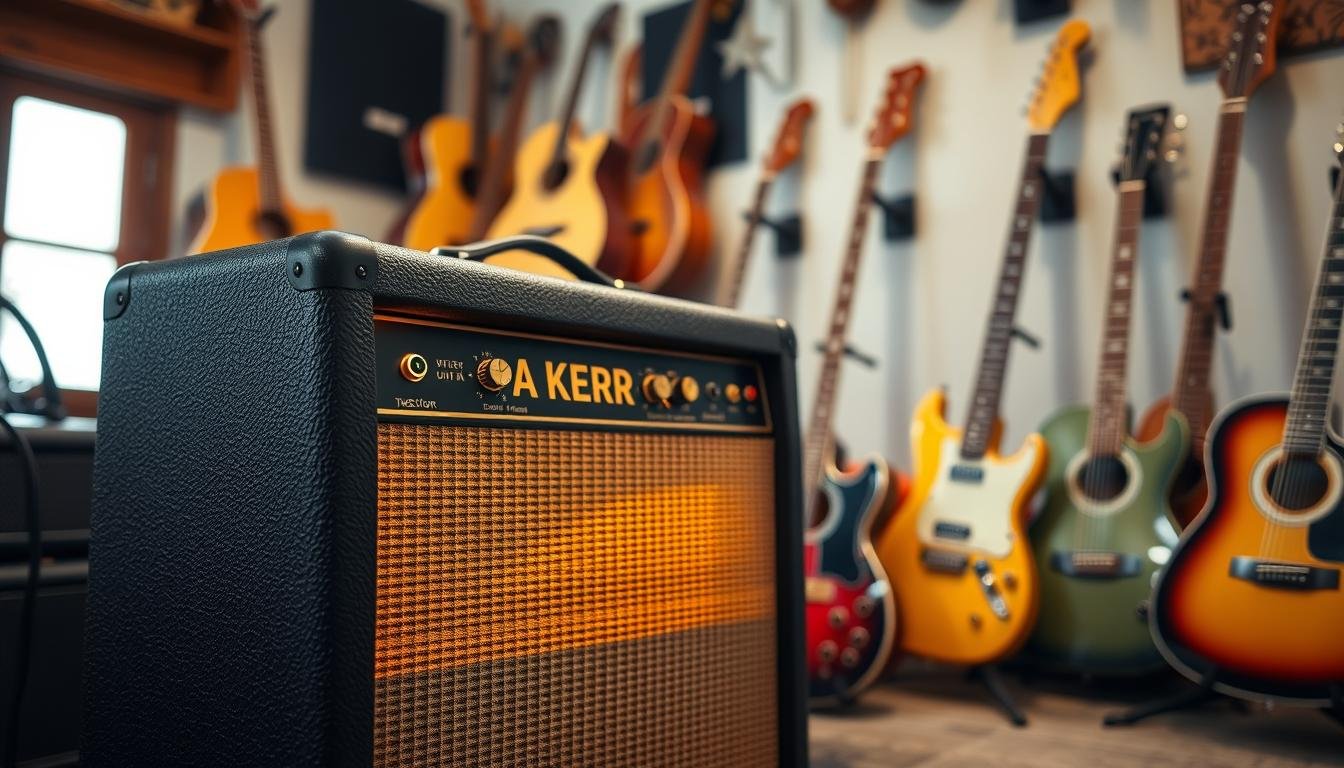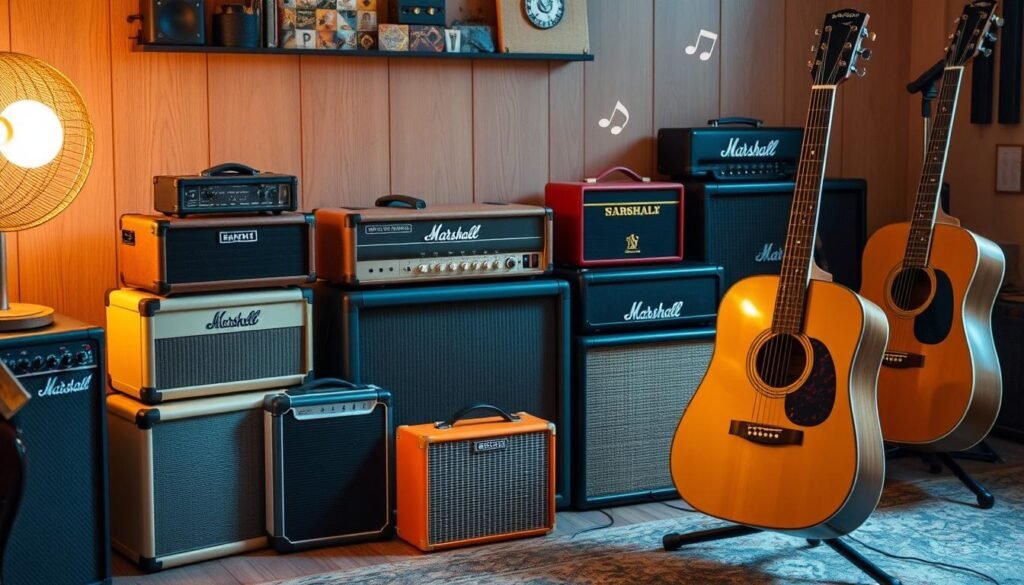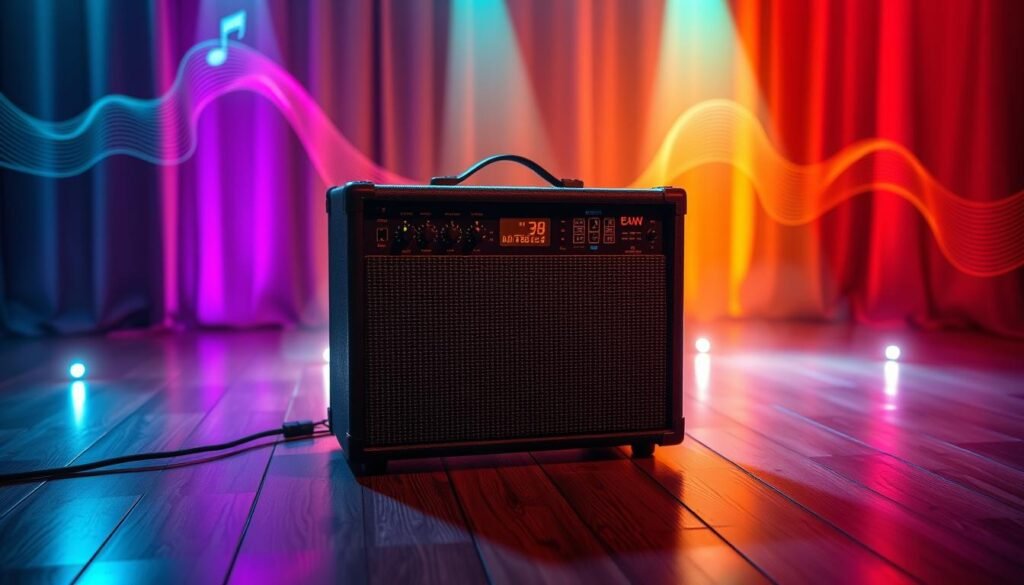Table of Contents Show
Choosing the right amplifier is crucial for a guitarist. The market offers many options, from classic tube amps to modern digital ones. Our guide to the best amp reviews for 2024 will help you find the perfect match for your style and budget. Get ready to improve your guitar skills and bring out the best in your instrument.
Imagine finding an amplifier that matches your tone and playing style perfectly. This article will help you understand the amplifier world. It will guide you to make a choice that enhances your music.
Key Takeaways
- Discover the latest amp reviews and market trends to make an informed purchasing decision.
- Understand the fundamentals of guitar amplifier technology, from vacuum tubes to solid-state designs.
- Explore the differences between premium tube amplifiers, budget-friendly practice amps, and professional stage performers.
- Delve into the world of digital modeling amplifiers and their advantages for recording and live performance.
- Learn how to choose the best amplifier based on your playing style, budget, and sound preferences.
Understanding Guitar Amplifier Basics
When we talk about hi-fi amp evaluations and power amplifier critiques, knowing the basics of guitar amps is key. These devices are the heart of a musician’s sound. They shape the tone and character of their instrument. Let’s explore the main points that define guitar amps.
Types of Guitar Amplifiers
Guitar amps come in different types, each with its own benefits. The most well-known types are:
- Combo amplifiers: These are all-in-one units that have both the amplifier and speaker in one box.
- Head and cabinet amplifiers: These separate the amplifier (head) from the speaker cabinet. This setup offers more flexibility and customization options.
Vacuum Tubes vs. Solid State Technology
The main difference in guitar amps is the technology used. Traditional vacuum tube amps are known for their warm, organic sound and natural distortion. On the other hand, solid-state amps give a more consistent and clean sound.
Power Output and Speaker Configurations
The power output of a guitar amp, measured in watts, affects the volume and headroom. Higher-wattage amps can handle louder performances and offer a more powerful sound. The speaker setup, like the number and size of speakers, also shapes the amp’s tone and presence.
Knowing these basics is crucial for choosing the right hi-fi amp or critiquing power amp performance. By understanding the different types, technologies, and specs, musicians and audio fans can find the perfect amp for their needs.
Latest Amp Reviews and Market Trends 2024
The guitar amplifier market has exploded with new releases in 2024. These show the latest in stereo amplifier assessments and sound quality reports. The industry now offers everything from digital modeling to classic tube designs, meeting the needs of today’s musicians.
Hybrid amplifiers are becoming more popular. They mix the warm sound of vacuum tubes with solid-state technology’s precision. Guitarists, both pros and amateurs, love them for their great sound and easy use.
| Amplifier Model | Technology | Power Output | Price |
|---|---|---|---|
| Fender Mustang GTX 100 | Hybrid (Tube + Solid-State) | 100W | $699 |
| Marshall DSL20CR | Tube | 20W | $799 |
| Boss Katana 50 MkII | Solid-State | 50W | $299 |
Digital modeling amplifiers are also on the rise. They offer many tone options and work well with modern recording and live setups. These are favorites among home recording fans and musicians looking for a versatile, compact option.
The guitar amplifier market keeps growing, with more advanced and feature-rich models. Whether you’re an experienced musician or just starting, the latest reviews and reports can help you find the right amplifier for you.
Premium Tube Amplifier Evaluations
For those who love music, a premium tube amplifier offers a unique listening experience. We dive deep into the world of high-end models and classic designs. We explore what makes vintage and modern tube amps different.
High-End Boutique Models
In the world of audiophile amp analyses, boutique tube amps stand out. They are loved by guitar fans for their amazing sound and craftsmanship. These amps have unique tones and beautiful designs, making them the best in amp value comparisons.
Classic Tube Amp Recommendations
Classic tube amps are also favorites among musicians and audiophiles. They have timeless sounds and are built to last. Whether you want a vintage Marshall or a Fender Deluxe, we can help you find the right one.
Vintage vs Modern Tube Designs
We also compare vintage and modern tube amps. Each has its own sound, thanks to different designs and materials. Knowing these differences can help you choose the perfect amp for your music.
“The warmth and responsiveness of a well-designed tube amplifier is something that simply can’t be replicated by solid-state or digital alternatives. It’s a visceral, organic experience that connects the player to their instrument in a way that’s truly special.”
Budget-Friendly Practice Amp Options
For beginners and intermediate guitarists, finding a good practice amplifier that’s affordable can be tough. But, there are many affordable options that sound great and have useful features. These amps are perfect for practicing at home, small gigs, and improving your skills.
Compact and Versatile Models
Budget-friendly practice amps are small and versatile. They pack a big sound in a small space, great for tight spots or traveling. They also have controls to shape your sound just right.
- Yamaha THR10II: A portable, battery-powered amp with a diverse selection of built-in effects and amp models.
- Fender Mustang LT25: An affordable, feature-rich combo amp with a wide array of digital modeling capabilities.
- Boss Katana Mini: A diminutive powerhouse that delivers impressive tone and flexibility in a compact design.
Prioritizing Sound Quality
Even though they’re affordable, these amps focus on sound quality. They’re made to give a great playing experience. This means you can practice and improve without losing out on tone.
| Model | Power Output | Speaker Configuration | Price Range |
|---|---|---|---|
| Fender Mustang LT25 | 25 watts | 1 x 8-inch speaker | $149 – $199 |
| Boss Katana Mini | 7 watts | 1 x 4-inch speaker | $99 – $129 |
| Yamaha THR10II | 10 watts | 2 x 3.15-inch speakers | $249 – $299 |
These budget-friendly practice amps are a great value. They’re perfect for those who want to improve their skills without spending a lot. They focus on sound quality and versatility, helping you build your tone and technique.
Professional Stage Amplifier Performance
Musicians and sound engineers need amplifiers that are top-notch. They look for sound quality, reliability, and durability for live shows. These amp performance ratings and amplifier sound quality reports are key for finding the right amplifier.
Live Sound Quality Assessment
Stage amplifiers aim to deliver a rich, powerful sound that fills the venue. They focus on tone, headroom, and clarity. This ensures the sound matches the artist’s vision.
Professional-grade models have controls and features for fine-tuning. This helps achieve the best sound for live performances.
Reliability and Durability Factors
Touring musicians can’t afford equipment failure. Professional stage amplifiers are made to last. They have rugged construction and reliable parts for the road.
Features like robust housing and thermal management systems are key. They help these amplifiers last longer.
Road-Worthy Features
- Multiple channels for switching between different tones and effects
- Integrated effects loops for seamless integration with pedals and processors
- Durable casing and reinforced handles for easy portability
- Comprehensive control panels with intuitive adjustments
- Phantom power support for condenser microphones
By focusing on amp performance ratings and amplifier sound quality reports, musicians can find the best amplifier. It should deliver great sound and last through the tour, ensuring reliable performance every night.
Digital Modeling Amplifier Technology
Digital modeling technology has changed the game in guitar amplifiers. These amps mimic the sounds of classic and modern amps. They offer a wide range of tones, from vintage to cutting-edge.
Brands like Line 6, Kemper, and Fractal Audio lead in this tech. They’ve studied and replicated the unique sounds of many amps. This lets guitarists easily switch between tones with just a button or knob.
Digital modeling amps are also super versatile. They come with built-in effects, so you don’t need extra pedals. Their easy-to-use interfaces make it simple for all players to explore new sounds.
Reviews and comparisons show digital modeling amps are a hit. They’re great for both new and experienced guitarists. These amps open up a world of sound, helping you find your unique voice.
“Digital modeling amplifiers have revolutionized the way I approach my tone. The ability to instantly switch between classic and modern amp sounds has truly expanded my creative horizons.”
The future of digital modeling amps looks bright. We can expect even more advanced features and realistic tones. Guitarists will have endless possibilities to express themselves and wow their audiences.
Best Recording Studio Amplifiers
Choosing the right amplifier is crucial for making professional-quality recordings. Musicians and producers need to consider several key factors when looking for the best studio amplifiers.
Studio-Specific Features
The best studio amplifier should have features made for recording. Look for ones with built-in attenuators to control volume without losing tone. Direct Injection (DI) outputs are also key, making it easy to connect with your recording console and digital audio workstation.
Recording Quality Comparison
Tube amplifiers are known for their warm, musical sound and natural compression. They’re a top choice for many in the industry. But, solid-state and digital modeling amplifiers have also improved a lot. They offer more flexibility and consistent sound.
Professional Engineer Recommendations
Listening to seasoned professionals is wise when picking studio amplifiers. Many experienced engineers and producers recommend certain models. They praise these amplifiers for their sound, versatility, and reliability in the studio.
| Amplifier Model | Professional Recommendation | Key Features |
|---|---|---|
| Fender Twin Reverb | Renowned for its clean, full-bodied tone and natural reverb, the Fender Twin Reverb is a studio staple for capturing classic rock and pop tones. | – 85-watt tube amplifier – 2 x 12″ speakers – Built-in spring reverb – DI output |
| Kemper Profiling Amplifier | The Kemper Profiling Amplifier is a digital modeling powerhouse that allows users to capture and recreate the unique characteristics of their favorite tube amplifiers. | – Digital modeling technology – Extensive library of amp profiles – Versatile connectivity options – Consistent tone and performance |
| Ampeg SVT-7PRO | Favored by bassists for its thunderous low-end response, the Ampeg SVT-7PRO is a reliable choice for recording tight, punchy bass tones. | – 700-watt tube bass amplifier – 8 x 10″ speaker configuration – Balanced XLR DI output – Extensive EQ and tone-shaping controls |
By focusing on studio-specific features, recording quality, and professional advice, musicians and producers can find the best studio amplifiers. These tools will help elevate their audio projects.
Essential Features for Different Playing Styles
Choosing the right guitar amplifier is key. Amp reviews and guides stress matching your gear to your style. Let’s look at the must-have features for different genres and styles.
Taming the Tone for Blues and Rock
Blues and rock players need an amp with strong overdrive and distortion. Look for amps with warm, punchy tones and adjustable gain. Tube-driven preamps and variable power output help achieve the iconic sounds of these genres.
Channeling Metal’s Aggression
Metal players want an amp for high-gain and aggressive tones. Look for amps with deep bass and the ability to produce sharp lead tones. Digital modeling and solid-state tech often provide the best metal sounds.
Capturing the Jazz Aesthetic
Jazz players need an amp that brings out their playing’s nuances. Choose amps with a clean sound, plenty of headroom, and gentle overdrive. These features let your guitar’s natural tone shine, perfect for jazzy playing.
Country Twang and Grit
Country players seek amps for that unique twang and grit. Look for amps with a focus on midrange, tight bass, and classic country tones. These features help capture the essence of country music.
Knowing what you need for your playing style helps you find the right amp. Use amp reviews and amplifier buying guides to find the perfect match for your music.
| Playing Style | Essential Amp Features |
|---|---|
| Blues and Rock | Responsive overdrive, warm tones, tube-driven preamps |
| Metal | High-gain, tight low-end, aggressive distortion |
| Jazz | Clean, transparent sound, excellent headroom, subtle overdrive |
| Country | Midrange-focused voicing, tight low-end, classic country tones |
“The right guitar amp can make all the difference in shaping your signature sound.”
Popular Brands and Their Signature Sound
Some brands in guitar amplifiers stand out, like Fender and Marshall. Each has a special sound that fits certain music styles. Knowing what makes these brands unique is key when stereo amplifier assessments and amp performance ratings are important.
Brand Comparison Guide
Fender is famous for its clean, bright sound. It’s perfect for classic rock and country. Their tube-driven amps, like the Deluxe Reverb, are loved for their warm feel and wide range.
Marshall is the go-to for hard rock and metal fans. Their amps, like the JCM800, offer a strong, distorted sound. This has been a favorite of many famous guitarists for years.
Vox amps are known for their bright, British Invasion sound. The AC30 is a classic example, with its clear tones and sensitive overdrive.
Market Position Analysis
While Fender, Marshall, and Vox lead the way, others have found their place too. Mesa Boogie, for example, is loved by metal and progressive rock players for its high-gain amps.
Orange Amplifiers are favorites for their unique look and organic sound. They’re perfect for blues, indie, and alternative rock musicians looking for something different.
These brands keep innovating, so every guitar player can find the right amp. Whether you’re into rock, metal, or something else, there’s an amp out there for you.
Conclusion
Choosing the right guitar amplifier is all about what you like, how you play, and how you plan to use it. This article has given you a detailed look at the latest trends, top-notch tube amps, affordable choices, and new digital tech.
If you’re an experienced musician or just starting out, there’s a lot to pick from. Look at things like sound quality, power, and how well it lasts. This will help you find the perfect amp for your music journey.
It’s important to try out different amps and listen to what sounds best to you. Try different brands and types to find the one that fits your style and sound. With the info from this amp reviews and amplifier buying guides, you’re ready to make a smart choice. You’ll find an amp that will help you improve your playing.







